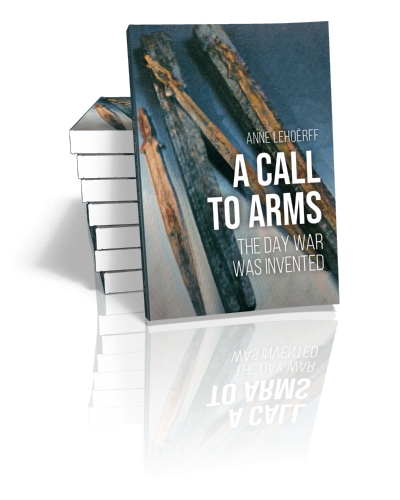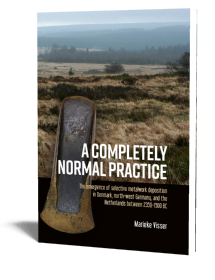A Call to Arms
The day war was invented
Anne Lehoërff | 2022

A Call to Arms
The day war was invented
Anne Lehoërff | 2022
Paperback ISBN: 9789464261042 | Hardback ISBN: 9789464261059 | Imprint: Sidestone Press | Format: 173x253mm | 204 pp. | Language: English | 0 illus. (bw) | 0 illus. (fc) | Keywords: prehistoric archaeology; warfare; swords; weaponry; metalcraft; metallurgy; Bronze Age | Translation: Tim Amstrong | download cover
Read online 322 times
- Digital & Online access
-
Buy via Sidestone (EU & UK)
-
Buy via our Distributors (WORLD)
For non-EU or UK destinations you can buy our books via our international distributors. Although prices may vary this will ensure speedy delivery and reduction in shipping costs or import tax. But you can also order with us directly via the module above.
UK international distributor
USA international distributor
-
Bookinfo
Paperback ISBN: 9789464261042 | Hardback ISBN: 9789464261059 | Imprint: Sidestone Press | Format: 173x253mm | 204 pp. | Language: English | 0 illus. (bw) | 0 illus. (fc) | Keywords: prehistoric archaeology; warfare; swords; weaponry; metalcraft; metallurgy; Bronze Age | Translation: Tim Amstrong | download cover
Read online 322 times

We will plant a tree for each order containing a paperback or hardback book via OneTreePlanted.org.
One day, sometime around 1700 BC, a bronzesmith made the first sword. This marked a technological turning point, giving rise to an arms race that has never since ceased. Soon, over a vast area between the Baltic Sea and the Atlantic Ocean, thousands of weapons were manufactured. They were used in combat, then laid to rest, whole or broken, often during complex rituals that are still hard for us to understand.
Through the sword, the Bronze Age brought war into being. The warrior became an important figure. Societies were transformed, and came to revolve politically and economically around warfare. Western Europe developed new social structures, a new kind of civilisation involving neither towns, nor writing.
By tackling the subject ‘a call to arms’, Anne Lehoërff investigates war’s long-term development. She focusses on oral societies which have for a long while remained poorly understood, passed over by a historical tradition that saw the world of Classical Antiquity in a different light to that of ‘primitive’ peoples. But our European ancestors have their own history, and this book tells it.
Anne Lehoërff is Professor of Archaeology at CY Cergy Paris University, and she presides the ‘Conseil National de la Recherche Archéologique’.
The French edition of A CALL TO ARMS was awarded the Verdun World Peace Center History Prize in 2018.
Introduction: Encountering War
How history comes to the historian
Going to war
History, a human science
Archaeology in history
War and European Protohistory revisited
What Wars?
Introductory narrative: Once upon a time, a warrior’s weapons…
War words
Theories of war
The philosophical angle
Stateless societies as seen by Europeans
The ‘savage’ beneath our feet
Ever more archaeological evidence
Archaeology and history
The ‘primitive’ in the city
The war of origins
The Celt of our dreams
And there was war…
Research ‘evidence’
Introductory narrative: Keeping Arms
An abundance of evidence
After the battle
The Metal Ages in pictures
Scenes of combat
The first battlefields
Sacred sites and cult objects
Skeletons and splinters
The Lessons of Bones
When Metal Speaks
Introductory narrative: The World of Metal
Fascinating metal
Metal choices in Europe
Unpicking harlequin’s cloak
Hierarchies that dare not speak their name
Deciphering and understanding
In the laboratory
Starting the investigation at the end
In the bronze smith’s cauldron
Under the metalworker’s hammer
A list of weapons
Narrative introduction: The bronze-smith in his workshop
The sword extends the arm
The sword evolves
And a scabbard…
The spear thickens
Arrows of outrageous fortune
The ambiguity of the hafted axe
A shield to protect the body
The metal helmet reinforces the warrior’s head
Metal to embellish the breast
Off to war
Introductory narrative: Taking up arms
Violence in the Palaeolithic
Multiple-use technology in the Neolithic
What kind of Neolithic ‘war’?
Declaring war in the Bronze Age
The revolution in fighting in 1700 BC
Multifaceted war in the Iron Age
Violence upon violence
Farewell to arms
Metal hoards
War in all its States
Introductory narrative: The 1000 BC warrior on the Normandy coast
Women: goddesses or sinners?
Masculine domination
Rich women without weapons
Transgressing norms
Reasons for war
The State, primitives, the written word. Terms of power.
What sort of society?
Three ages of war?
Words and functions for all
The West in the dynamics of warfare
Conclusion: The human level
Questions of scale
War and peace
A trip to the Bronze Age kitchen
Prof. dr. Anne Lehoërff
Anne Lehoërff is an archaeologist, archaeometallurgist and historian. She has an “agréation” in history, was member of the Ecole française de Rome, and director of the European ‘BOAT 1550’ project (2011-2015) investigating cross-channel navigation between the continent and the British Isles in the second millennium BC. Until 2020 Anne Lehoërff was a university professor at the university of Lille. She is now professor of ‘Archaeology and Patrimony’ at the University of CY Cergy Paris-Université, specialising in the European Bronze Age.
Abstract:
One day, sometime around 1700 BC, a bronzesmith made the first sword. This marked a technological turning point, giving rise to an arms race that has never since ceased. Soon, over a vast area between the Baltic Sea and the Atlantic Ocean, thousands of weapons were manufactured. They were used in combat, then laid to rest, whole or broken, often during complex rituals that are still hard for us to understand.
Through the sword, the Bronze Age brought war into being. The warrior became an important figure. Societies were transformed, and came to revolve politically and economically around warfare. Western Europe developed new social structures, a new kind of civilisation involving neither towns, nor writing.
By tackling the subject ‘a call to arms’, Anne Lehoërff investigates war’s long-term development. She focusses on oral societies which have for a long while remained poorly understood, passed over by a historical tradition that saw the world of Classical Antiquity in a different light to that of ‘primitive’ peoples. But our European ancestors have their own history, and this book tells it.
Anne Lehoërff is Professor of Archaeology at CY Cergy Paris University, and she presides the ‘Conseil National de la Recherche Archéologique’.
The French edition of A CALL TO ARMS was awarded the Verdun World Peace Center History Prize in 2018.
Contents
Introduction: Encountering War
How history comes to the historian
Going to war
History, a human science
Archaeology in history
War and European Protohistory revisited
What Wars?
Introductory narrative: Once upon a time, a warrior’s weapons…
War words
Theories of war
The philosophical angle
Stateless societies as seen by Europeans
The ‘savage’ beneath our feet
Ever more archaeological evidence
Archaeology and history
The ‘primitive’ in the city
The war of origins
The Celt of our dreams
And there was war…
Research ‘evidence’
Introductory narrative: Keeping Arms
An abundance of evidence
After the battle
The Metal Ages in pictures
Scenes of combat
The first battlefields
Sacred sites and cult objects
Skeletons and splinters
The Lessons of Bones
When Metal Speaks
Introductory narrative: The World of Metal
Fascinating metal
Metal choices in Europe
Unpicking harlequin’s cloak
Hierarchies that dare not speak their name
Deciphering and understanding
In the laboratory
Starting the investigation at the end
In the bronze smith’s cauldron
Under the metalworker’s hammer
A list of weapons
Narrative introduction: The bronze-smith in his workshop
The sword extends the arm
The sword evolves
And a scabbard…
The spear thickens
Arrows of outrageous fortune
The ambiguity of the hafted axe
A shield to protect the body
The metal helmet reinforces the warrior’s head
Metal to embellish the breast
Off to war
Introductory narrative: Taking up arms
Violence in the Palaeolithic
Multiple-use technology in the Neolithic
What kind of Neolithic ‘war’?
Declaring war in the Bronze Age
The revolution in fighting in 1700 BC
Multifaceted war in the Iron Age
Violence upon violence
Farewell to arms
Metal hoards
War in all its States
Introductory narrative: The 1000 BC warrior on the Normandy coast
Women: goddesses or sinners?
Masculine domination
Rich women without weapons
Transgressing norms
Reasons for war
The State, primitives, the written word. Terms of power.
What sort of society?
Three ages of war?
Words and functions for all
The West in the dynamics of warfare
Conclusion: The human level
Questions of scale
War and peace
A trip to the Bronze Age kitchen
Prof. dr. Anne Lehoërff
Anne Lehoërff is an archaeologist, archaeometallurgist and historian. She has an “agréation” in history, was member of the Ecole française de Rome, and director of the European ‘BOAT 1550’ project (2011-2015) investigating cross-channel navigation between the continent and the British Isles in the second millennium BC. Until 2020 Anne Lehoërff was a university professor at the university of Lille. She is now professor of ‘Archaeology and Patrimony’ at the University of CY Cergy Paris-Université, specialising in the European Bronze Age.
- Digital & Online access
-
Buy via Sidestone (EU & UK)
-
Buy via our Distributors (WORLD)
For non-EU or UK destinations you can buy our books via our international distributors. Although prices may vary this will ensure speedy delivery and reduction in shipping costs or import tax. But you can also order with us directly via the module above.
UK international distributor
USA international distributor
- Browse all books by subject
-
Search all books

We will plant a tree for each order containing a paperback or hardback book via OneTreePlanted.org.
You might also like:
© 2025 Sidestone Press KvK nr. 28114891 Privacy policy Sidestone Newsletter Terms and Conditions (Dutch)








